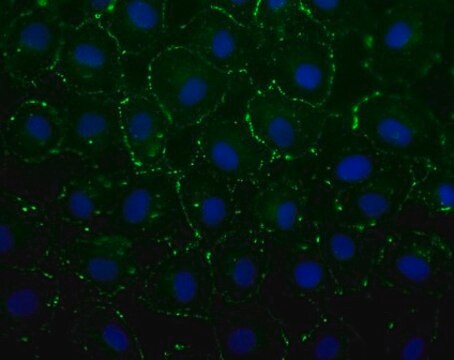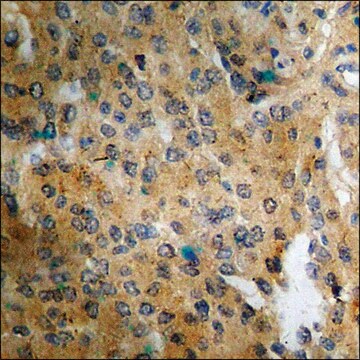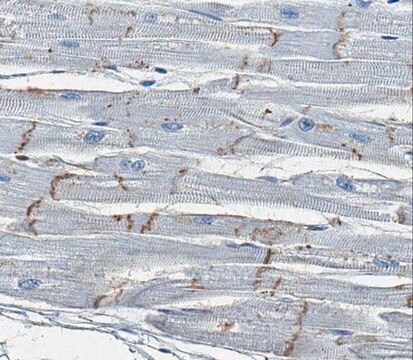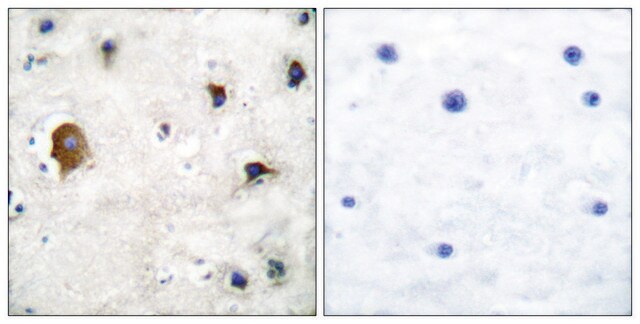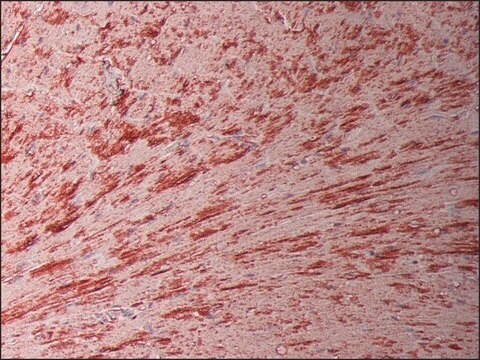MABT903
Anti-Connexin 43 Antibody, N-terminal Antibody, clone P1E11.B19
clone P1E11, from mouse
Synonym(s):
Gap junction alpha-1 protein, CX43, Gap junction 43 kDa heart protein
About This Item
Recommended Products
biological source
mouse
Quality Level
antibody form
purified immunoglobulin
antibody product type
primary antibodies
clone
P1E11, monoclonal
species reactivity
mouse, rat, human
species reactivity (predicted by homology)
bovine (based on 100% sequence homology), rabbit (based on 100% sequence homology), horse (based on 100% sequence homology), canine (based on 100% sequence homology), rhesus monkey (based on 100% sequence homology), chicken (based on 100% sequence homology), hamster (based on 100% sequence homology), porcine (based on 100% sequence homology)
technique(s)
immunocytochemistry: suitable
western blot: suitable
isotype
IgG1κ
NCBI accession no.
UniProt accession no.
shipped in
ambient
target post-translational modification
unmodified
Gene Information
bovine ... Gja1(281193)
chicken ... Gja1(395278)
dog ... Gja1(403418)
horse ... Gja1(100067229)
human ... GJA1(2697)
mouse ... Gja1(14609)
rabbit ... Gja1(100008935)
rat ... Gja1(24392)
rhesus monkey ... Gja1(714344)
General description
Specificity
Immunogen
Application
Cell Structure
Western Blotting Analysis (WB): A representative lot detected Connexin 43 in NRK cells (Courtesy of Joell Solan in Paul Lampe s Lab at Fred Hutchinson Cancer Research Center, Seattle, WA).
Western Blotting Analysis: A representative lot detected Connexin 43 in Western Blotting applications (Kalcheva, N., et. al. (2007). Proc Natl Acad Sci USA. 104(51):20512-6).
Western Blotting Analysis: 1-4 µg/mL from a representative lot detected Connexin 43 in 10 µg of rat and mouse heart tissue lysates.
Immunocytochemistry Analysis: A representative lot detected Connexin 43 in Immunocytochemistry applications (Gellhaus, A., et. al. (2004). J Biol Chem. 279(35):36931-42).
Western Blotting Analysis: A representative lot detected Connexin 43 in Western Blotting applications (Goldberg, G.S., et. al. (2002). J Biol Chem. 277(39):36725-30).
Western Blotting Analysis: A representative lot detected Connexin 43 in Western Blotting applications (Solan, J.L., et. al. (2003). J Cell Sci. 116(Pt 11):2203-11).
Quality
Western Blotting Analysis: 1 µg/mL of this antibody detected Connexin 43 in 10 µg of human heart tissue lysates.
Target description
Physical form
Storage and Stability
Other Notes
Disclaimer
Not finding the right product?
Try our Product Selector Tool.
Storage Class Code
12 - Non Combustible Liquids
WGK
WGK 1
Certificates of Analysis (COA)
Search for Certificates of Analysis (COA) by entering the products Lot/Batch Number. Lot and Batch Numbers can be found on a product’s label following the words ‘Lot’ or ‘Batch’.
Already Own This Product?
Find documentation for the products that you have recently purchased in the Document Library.
Our team of scientists has experience in all areas of research including Life Science, Material Science, Chemical Synthesis, Chromatography, Analytical and many others.
Contact Technical Service